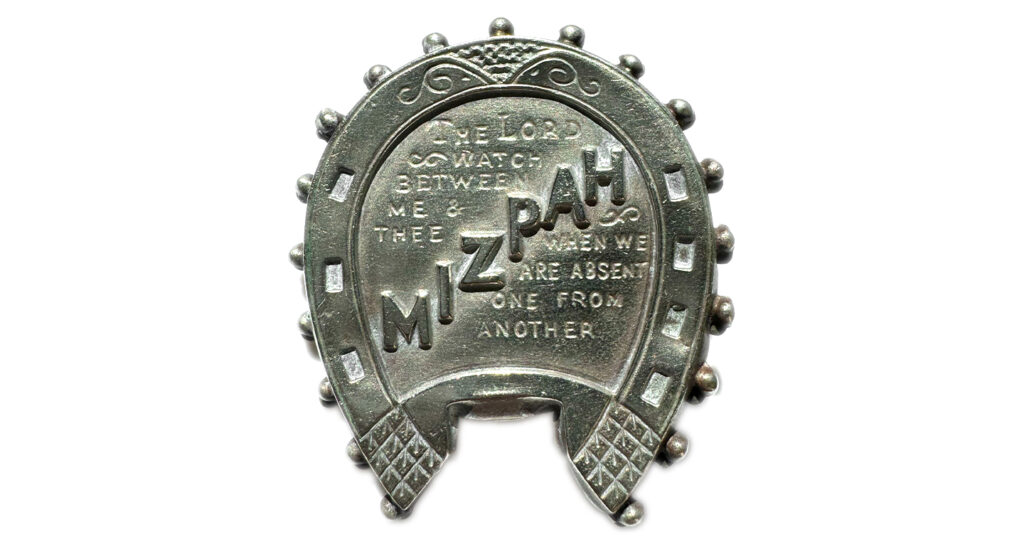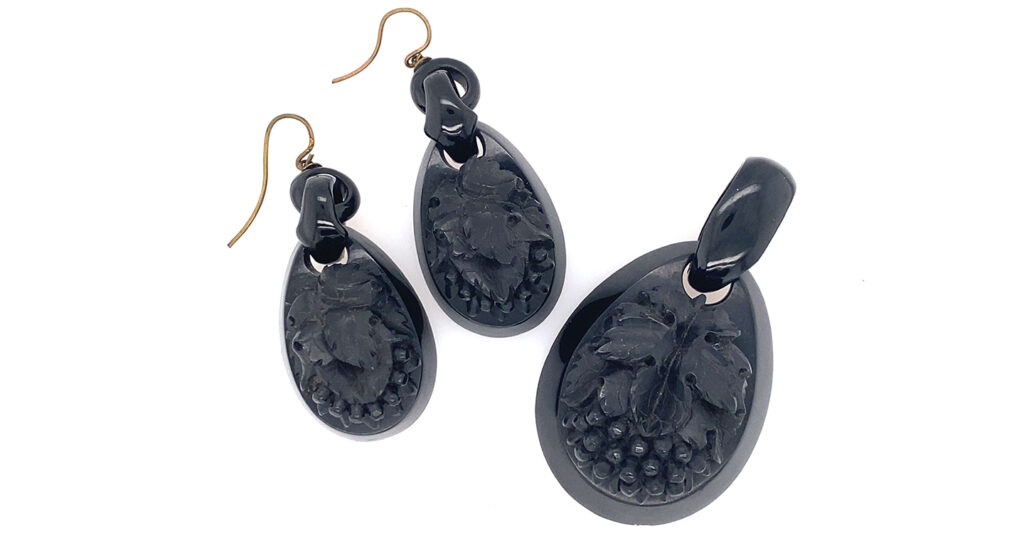Myrtle Symbolism in Jewels
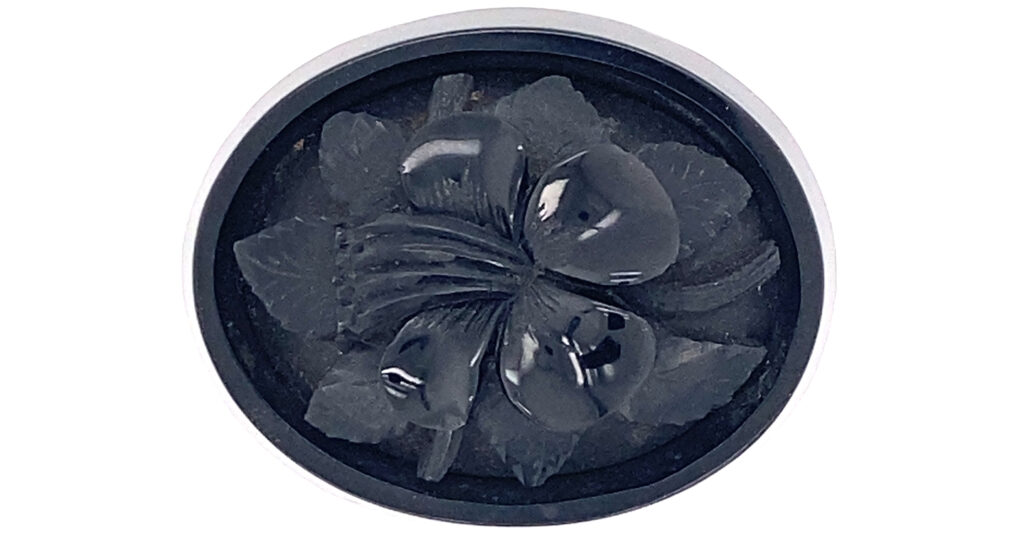
The Museum of Whitby Jet is a genuine establishment of living history. Combined with the store W. Hamond, it presents the oldest connection to 19th century Whitby Jet manufacture that still exists. It is a tribute to the 1500 men and 200 shops that existed in 1873 to produce the finest quality of Jet available in the world. Their craft, of carving, turning and polishing jet held a standard that set the British Empire beyond any other jet industry in the world, being held in the highest regard by Queen Victoria herself.
Due to the popularity of Whitby Jet, the instances of its carving designs are almost infinite. The Victorians relished the romantic and sentimental language of flowers. They were educated, had access to new wealth and were the first affluent middle class that could afford leisure time. Travel was a part of seasonal Victorian lifestyle and cottage industries emerged with the connection of rail lines that ferried these sentimental people across Britain. Whitby’s popularity as the centre of Jet fed its local community and its economy. Carvers were charged with appealing to the most popular designs from the visitors, who requested sentimental tokens to gift to their loved ones.
This Art of Mourning series is in partnership with the Museum of Whitby Jet and is a look at the jewels of the museum through the eyes of the Victorians who requested and understood the love language of flowers.
To achieve this, part 1 of the series is an introduction to Whitby Jet, which can be read below:
Link > Discover Whitby Jet
Part 2 is an understanding of ‘floriography’, a late 18th and 19th century attempt by philosophers and writers to connect floral discoveries of the world to emotion to empirical fact. This can be read below:
Link > Understanding Symbolism: Botany and Floriography
Symbolism of Myrtle

19th century values of love and the etiquette of forming a relationship were linked to romanticism, classicism and chivalry. Designs in jewellery were made to represent these values and provide a basis for an educated society to further understand their meaning. Myrtle has a strong connection to history and poetry, which was outlined by the writers and philosophers who catalogued flowers for the fascination with ‘floriography’. This is where the scientific and poetic/emotional meaning was assigned of flowers, providing the educated Victorians with their meanings. Floral Emblems, by Henry Phillips, published in 1825, The Language of Flowers with Illustrated Poetry, by Frederic Shoberl in 1839 and The Illustrated Language of Flowers, Mrs L. Burke in 1856 all detailed the meaning of the Myrtle, which has the most important value of all; love.
Relating flowers to classical mythology was important for the Enlightenment’s values of connecting modern society back to classical knowledge and society. Phillips writes in 1825 that myrtle is related to Venus (goddess of love and beauty):
“Mythological writers state that when Venus first sprang from the bosom of the waves, the Hours preceded her with a garland of myrtle, since which it has been dedicated to the goddess of beauty, and made the emblem of love.”
With its basis in Venus, the myrtle can then be used in allegorical poetry for the meaning of love and beauty. Phillips goes on to quote the poets Drayton and Thompson in their usage of myrtle, giving a good insight into the thoughts of what myrtle’s symbolism was in the early 19th century.
Shoberl elaborates on the connection to the gods and the use of myrtle:
“At Rome the temple of the goddess was surrounded by a grove of Myrtles; and in Greece she was adored under the name of Myrtilla. When Venus rose from the bosom of the waves, the Hours presented to her a scarf of a thousand colours, and a wreath of Myrtle. After her victory over Pallas and Juno, she was crowned with Myrtle by the Loves. When surprised, one day, on issuing from the bath, by a troop of satyrs, she sought refuge behind a Myrtle bush; and it was with the branches of the same plant that she revenged herself on the audacious Psyche, who dared to compare her transitory charms to immortal beauty.
At Rome the Myrtle-garland of the Loves was sometimes mingled, in honour of Mars and Venus, with the laurel on the triumphant conqueror’s a brow. And now that triumphs have ceased at the Capitol, the Roman ladies have retained a strong predilection for this plant. They prefer its odour to that of the most fragrant essences, and they impregnate their baths with a water distilled from its leaves, persuaded that the plant of Venus must be favourable to beauty. If the ancients were possessed by a similar persuasion, if they truly deemed it the symbol of love, it was because they had observed that the Myrtle, wherever it grows, excludes all other plants. Just so love, wherever it has established its sway, excludes from the heart all other feelings.”
By 1856, the meaning of the myrtle was well established, by Burke, with her clear meaning of love as its symbolism. This is a publication that would have been used for the daily understanding of flowers by the Victorian lady and cements its meaning. She incorporates Poems for Youth by a Family Circle in the description, reminding the reader about the classical history associated with myrtle:
THE MYRTLE.
Bright glowed the Myrtle’s verdant pride,
That near my lonely cottage sprung;
But on the gale of eventide,
The tree no grateful odours flung.
Once with rude hand a branch I tore,
And all its tender leaflets prest ;
Wh n , pouring forth its hidden store,
Its native sweetness stood confest.
‘Tis thus in life’s untroubled day,
The virtuous mind its charms withholds
Nor always ventures to display
That excellence the heart enfolds.
But when severe misfortunes rise,
Its genuine worth is felt and proved ;
And whilst it suffers, droops, ordies,
‘Tis doubly cherished, mourned, and loved.
Poems for Youth by a Family Circle.
Connecting jewellery history to the society in which it was created is essential to understanding its meaning. When a floral design is incorporated into a jewel, its message remains there. Applying modern thought to a symbol, outside of its social context, won’t allow us to understand how people behaved in history. Myrtle, love and classicism are all brought together through the lens of Venus and the tokens of love would have been given with a powerful message of adoration.
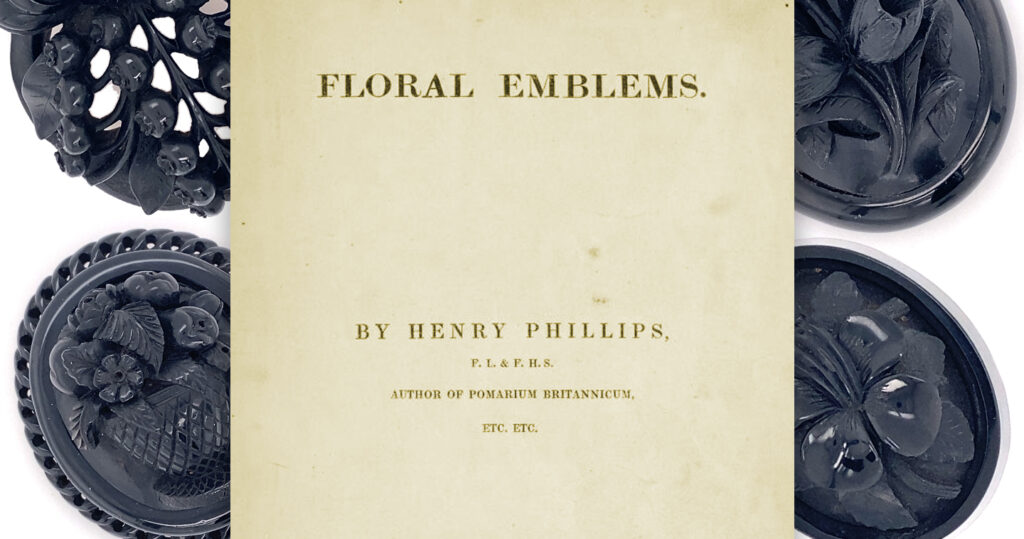
LOVE.
Myrtle. – Myrtus.
“ The lover’ myrtle.”
“ Like a myrtle tree in flower
Taken from an Asian bower,
Where with many a dewy cup, а.
Nymphs in play had nursed it up.”
Hunt’s Catullus.
“The lover with the myrtle sprays,
Adorns his crisped tresses.”
Drayton.
Mythological writers state that when Venus first sprang from the bosom of the waves, the Hours preceded her with a garland of myrtle, since which it has been dedicated to the goddess of beauty, and made the emblem of love.
“Imperial passion! sacred fire!
When we of meaner subjects sing,
Thou tun’st our harp, thou dost our souls inspire;
‘Tis love directs the quill, ’tis love strikes every string.”
Thompson.
Floral Emblems, p.202
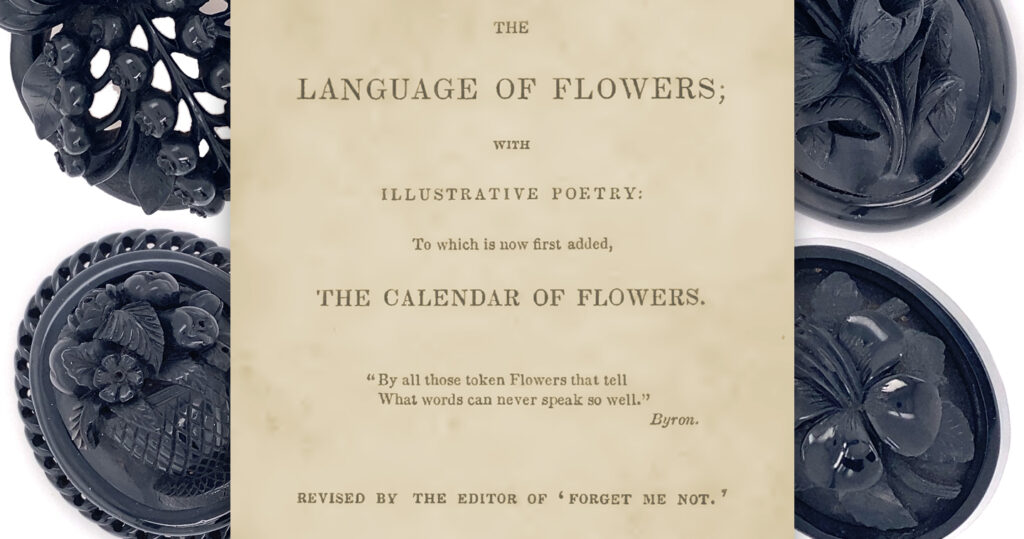
MYRTLE.
Love.
MYRTLE.
LOVE.
THE oak was from the remotest ages consecrated to Jupiter, the olive to Minerva, and the Myrtle to Venus. Its evergreen foliage and supple odoriferous branches loaded with flowers, that appear destined to adorn the forehead of Love, have rendered this tree worthy of being dedicated to Venus, the goddess of beauty. At Rome the temple of the goddess was surrounded by a grove of Myrtles; and in Greece she was adored under the name of Myrtilla. When Venus rose from the bosom of the waves, the Hours presented to her a scarf of a thousand colours, and a wreath of Myrtle. After her victory over Pallas and Juno, she was crowned with Myrtle by the Loves. When surprised, one day, on issuing from the bath, by a troop of satyrs, she sought refuge behind a Myrtle bush; and it was with the branches of the same plant that she revenged herself on the audacious Psyche, who dared to compare her transitory charms to immortal beauty.
At Rome the Myrtle-garland of the Loves was sometimes mingled, in honour of Mars and Venus, with the laurel on the triumphant conqueror’s brow. And now that triumphs have ceased at the Capitol, the Roman ladies have retained a strong predilection for this plant. They prefer its odour to that of the most fragrant essences, and they impregnate their baths with a water distilled from its leaves, persuaded that the plant of Venus must be favourable to beauty. If the ancients were possessed by a similar persuasion, if they truly deemed it the symbol of love, it was because they had observed that the Myrtle, wherever it grows, excludes all other plants. Just so love, wherever it has established its sway, excludes from the heart all other feelings.
The Language of Flowers, p.104

Myrtle… Love.
THE MYRTLE.
Bright glowed the Myrtle’s verdant pride,
That near my lonely cottage sprung;
But on the gale of eventide,
The tree no grateful odours flung.
Once with rude hand a branch I tore,
And all its tender leaflets prest ;
Wh n , pouring forth its hidden store,
Its native sweetness stood confest.
‘Tis thus in life’s untroubled day,
The virtuous mind its charms withholds
Nor always ventures to display
That excellence the heart enfolds.
But when severe misfortunes rise,
Its genuine worth is felt and proved ;
And whilst it suffers, droops, ordies,
‘Tis doubly cherished, mourned, and loved.
Poems for Youth by a Family Circle.
The Illustrated Language of Flowers, p.40




